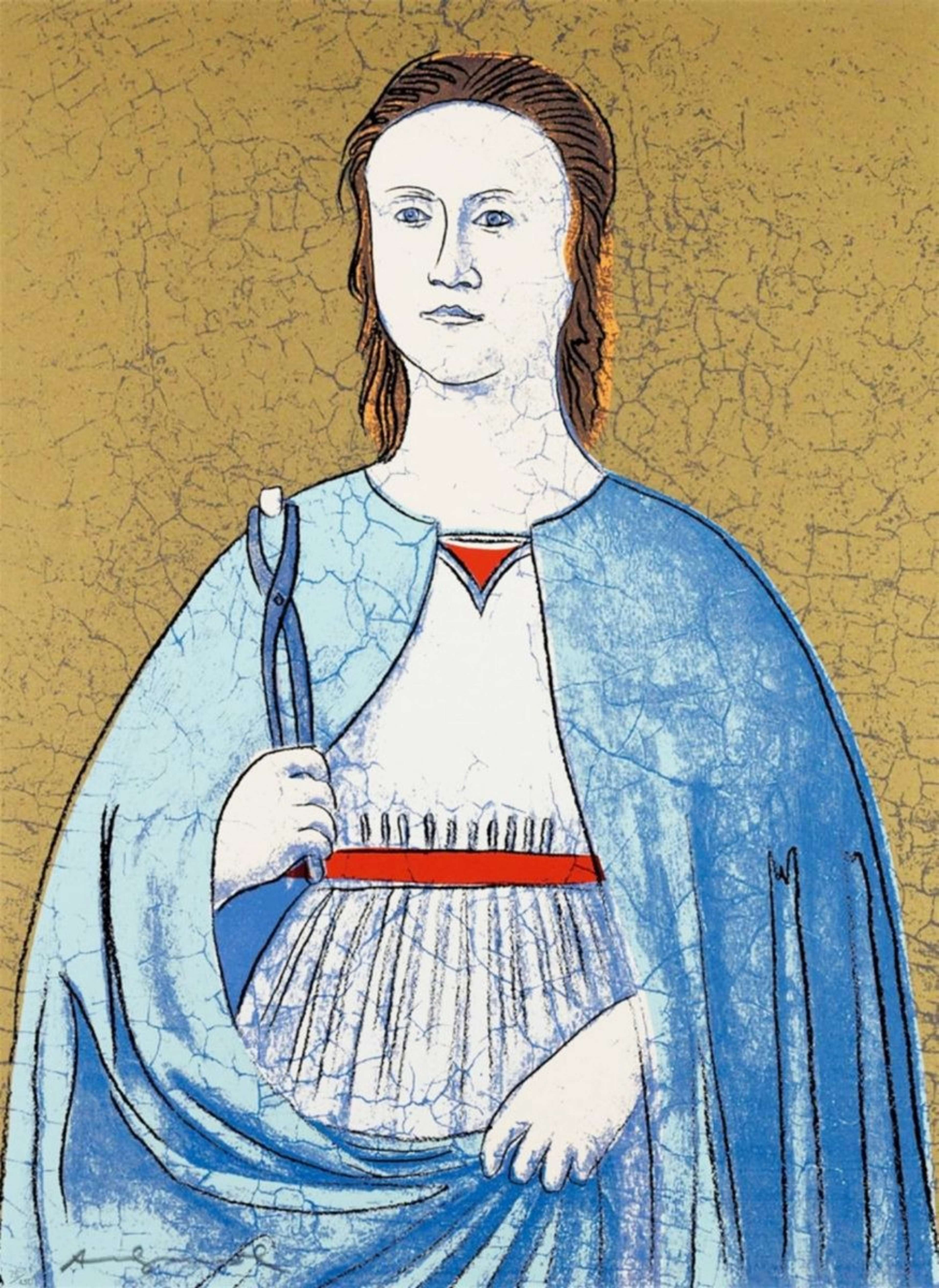 Saint Apollonia (F. & S. II.333) © Andy Warhol 1984
Saint Apollonia (F. & S. II.333) © Andy Warhol 1984
Interested in buying or selling
Andy Warhol?

Andy Warhol
487 works
Saint Apollonia is an uncharacteristically pious series by Andy Warhol, depicting the martyr and patron saint of dentistry. The series speaks to Warhol's Catholic faith, and his unrelenting fascination with art history.
The series depicts Saint Apollonia, the martyr and patron saint of dentistry.
 Saint Apollonia (F. & S. II.330) © Andy Warhol 1984
Saint Apollonia (F. & S. II.330) © Andy Warhol 1984Though it might appear unusual, at first, for Warhol to turn his attention to Christian saints, his Saint Apollonia series is characteristically whimsical. Apollonia, the patron saint of dentistry, surrendered herself to martyrdom after a pagan mob tortured her by extracting her teeth. Indeed, she was a strange saint for Warhol to choose, but an eccentric choice typical of his oeuvre nonetheless.
The prints are inspired by a portrait of Apollonia by Piero della Francesca.
 Image © National Gallery of Art Washington / Saint Apollonia © Piero della Francesca c.1455/1460
Image © National Gallery of Art Washington / Saint Apollonia © Piero della Francesca c.1455/1460Painted between 1455-60, Piero della Francesca depicted Saint Apollonia on a gold ground, as was typical of Italian altar paintings from this period. Warhol’s screen printed series mimics Francesca’s original painting almost exactly, merely reimagining her portrait with bold colours to announce her as a modern deity.
The series is typical of Warhol's focus on historical subjects in the 1980s.
 Beethoven (F. & S. II.392) © Andy Warhol 1987
Beethoven (F. & S. II.392) © Andy Warhol 1987Warhol was a devout Catholic.
 Cologne Cathedral (F. & S. II.364) © Andy Warhol 1985
Cologne Cathedral (F. & S. II.364) © Andy Warhol 1985Throughout his life, Warhol was a practicing and committed Byzantine Catholic. When the Pop Artist lived with his mother in New York, the pair would pray daily together. Warhol attended mass until his death in 1987, and this series is one of the rare instances in which Warhol expressed his faith through art.
This wasn't the first time Warhol depicted a religious idol.
 Details Of Renaissance Paintings (Leonardo Da Vinci, The Annunciation, 1472) (F. & S. II.322) © Andy Warhol 1984
Details Of Renaissance Paintings (Leonardo Da Vinci, The Annunciation, 1472) (F. & S. II.322) © Andy Warhol 1984In his Renaissance Paintings series, created in the same year as the Saint Apollonia series, Warhol reimagined Leonardo da Vinci's The Annunciation. In his rendition of the infamous painting, Warhol depicted only the hands of the Virgin Mary and the Angel Gabriel, heightening the divine gesture passing between them. Though Warhol had rarely depicted religious subject matter earlier in his oeuvre, 1984 seemed to be the year that Warhol increasingly turned towards Christian iconography and history.
Warhol alludes to Apollonia's fate in these prints.
 Saint Apollonia (F. & S. II.332) © Andy Warhol 1984
Saint Apollonia (F. & S. II.332) © Andy Warhol 1984Mirroring Francesca's original painting, Warhol's Saint Apollonia boldly holds a pair of pinchers holding a tooth. The prop alludes to Apollonia's fate, as she was tortured by having her teeth extracted, and also signifies her as the patron saint of dentistry.
Warhol barely cropped the original painting.
 Details of Renaissance Paintings (Paolo Uccello St George and the Dragon 1460) (F. & S. II.327) © Andy Warhol 1984
Details of Renaissance Paintings (Paolo Uccello St George and the Dragon 1460) (F. & S. II.327) © Andy Warhol 1984Unlike his Renaissance Paintings series, where Warhol focused on detailed sections of famous paintings, Saint Apollonia is - more or less - an exact copy of Francesca's original composition. Like Warhol's portraits of modern icons like Marilyn Monroe and Liz Taylor, Francesca's Saint Apollonia pictures the saint face-on and gazing out towards the viewer.
Warhol mimics the cracks in Francesca's original painting.
 Saint Apollonia (F. & S. II.333) © Andy Warhol 1984
Saint Apollonia (F. & S. II.333) © Andy Warhol 1984With his thick layering of screen printing inks, Warhol mimicked the cracks in Francesca's original painting. In doing so, Warhol gave the impression that his vibrantly coloured screen print visions of Apollonia were historical artefacts, rather than a modern Pop appropriaiton.
Warhol imagined Apollonia as a Pop icon in this series.
 Saint Apollonia (F. & S. II.331) © Andy Warhol 1984
Saint Apollonia (F. & S. II.331) © Andy Warhol 1984With his application of striking colour and graphic outlines, Warhol envisioned Apollonia as a modern saint, not dissimilar to the celebrities he elevated to a quasi-religious status. Though Warhol retained the demure appearance of Apollonia, outlining her face with simple lines and minimal shading, he modernised her portrait to appear like one of his more typical subjects.
The series is telling of Warhol's fascination with art history.
 Details Of Renaissance Paintings (Sandro Botticelli, Birth Of Venus, 1482) (F. & S. II.319) © Andy Warhol 1984
Details Of Renaissance Paintings (Sandro Botticelli, Birth Of Venus, 1482) (F. & S. II.319) © Andy Warhol 1984As we see in his Renaissance Paintings and Saint Apollonia series, Warhol became increasingly invested in art history towards the end of his life and artistic career. Perhaps his growing occupation with history and the so-called ’Old Masters’ was Warhol's way of navigating his own position in the history of art, pronouncing his own status as a modern master.
